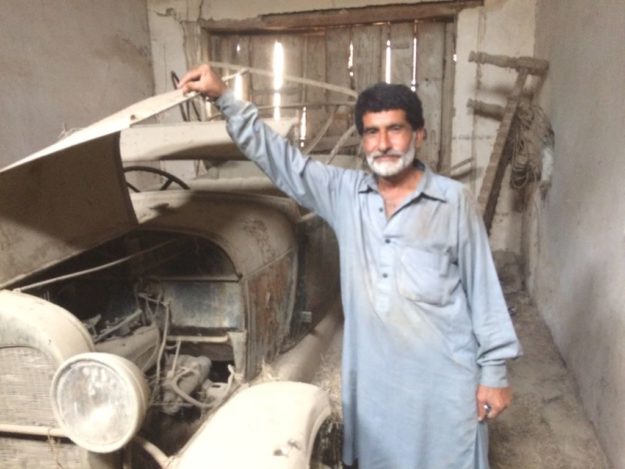
PESHAWAR: With even prominent names in the Pakistan movement being lost to dust-covered archives of history, in Bannu, a 90-year-old car is the last testament to a man who helped further the cause of a separate homeland for Muslims in the Indian subcontinent.
In an old brick and mortar garage in Bazaar Ahmad Khan, a well-known and historic village of Bannu in Khyber-Pakhtunkhwa, a 1928 Ford Model A stands covered in dust and rust. Its original paint almost indistinguishable from the rusting red and its front grille shorn of its once shiny chrome.
“One of our cousins does not allow anyone to touch the car or the garage,” notes Iftikhar Khan, a grandson of Khan Bahadur Ghulam Haider Khan who originally owned the vehicle and large swathes of land.

Owner with the vintage car.
Known as Khan Bahadur in the area, he was the main landlord of Bannu in undivided India.
The city had been formed by Sir Herbert Benjamin Edwardes in 1848 to serve the then British Empire as a supply depot and garrison against the Pashtun tribes in Waziristan. Khan Bahadur’s family was awarded large swaths of land in the area. His village soon became the centre of trade and commerce in the district.
Little did the British know that less than hundred years after creating the city, that the man they counted on most for support would help overthrow the British government and carve out a homeland.
Indeed, Khan Bahadur played a massive role in first furthering the cause of the Pakistan movement and then by providing it with its future president, Ghulam Ishaq Khan — a historic fact little known outside the village.
“Khan Bahadur joined the All India Muslim League along with other notable family members including his son-in-law Malik Damsaz at a time when the entire district was in the grip of the Red Shirts’ (Khudai Khidmatgaar – servants of God) mania,” said Ifran Khan, another of Khan Bahadur’s grandsons.
He pointed out that at that point the social reform movement led by Khan Abdul Ghaffar Khan (affectionately known as Bacha Khan) was seeping the region. The movement, which propagated a similar agenda of self-rule, had been rebuffed by the All India Muslim League (AIML) and courted by Mahatma Gandhi of the Indian National Congress.
Khan Bahadur though pushed on with the AIML and to form Pakistan.
The car, too, is said to have played a part. Irfan said that it was included in a convoy for Quaid-e-Azam Mohammad Ali Jinnah when he visited the region in the mid-1940s.
“This vehicle was used during Jinnah’s visit to Bannu in the mid-1940s,” Iftikhar said while pointing to the dilapidated car.
“There is a common belief that it was used by Jinnah during his tour to Bannu but this is not true because there were too many vehicles at the time, which primarily belonged to Malik Damsaz and Khan Bahadur and other party leaders. This car was kept in reserve in case of an emergency,” he added.
Iftikhar further said that at the time, Khan Bahadur had emerged as a prominent AIML supporter and leader.
This, he said, did not please the then Chief Minister of NWFP Khan Abdul Qayum Khan, who tried his level best to damage prominent AIML leaders in the province politically.
Khan Bahadur was no exception to this.
“Qayum could stand no political opposition and he sidelined and destroyed all those who could even become potential rivals in any way,” he added.
But despite their role in the creation of Pakistan, Khan Bahadur and Malik Damsaz were forgotten by history. The car too would have been lost to history had it not been for the preservation by Khan Bahadur’s family.
“Khan Bahadur and Malik Damsaz’s role in Pakistan Movement cannot be ignored. They should have been treated as national heroes but people hardly know their names,” lamented Iftikhar.
He added that after Khan Bahadur’s death, all his moveable and immovable property was divided amongst his children and then his grandchildren.
Only a small building, which serves as the garage for the car, and the car itself have survived, Iftikhar said. The building and the car have been locked up since 1965 and are in a state of disrepair.
“I think that it is the responsibility of the federal government to restore this beautiful car to pay homage to the contribution and efforts of Khan Bahadur,” he added, noting that lack of maintenance would further see this piece of Pakistan’s history deteriorate further.
Ghulam Ishaq Khan’s rise
Being a landed individual of considerable influence, Khan Bahadur left his imprint on Pakistan in a host of ways. One of these was to set former president Ghulam Ishaq Khan on the right path.
“President Ghulam Ishaq Khan was quite talented but in his youth, he was quite unruly,” Irfan pointed out.
“One day, Ghulam’s mother visited Khan Bahadur at his house and met with his wife. In that meeting, she complained that her son was not taking interest in anything useful and was jobless. She asked for a favour from Khan Bahadur that her son be provided with a government job to keep him busy and away from bad company,” Irfan narrated.
“My grandfather was a close friend of Sir Abdul Qayum Khan, the founder of the Islamia College in Peshawar. Khan Bahadur asked him to arrange for a job for the young Ghulam Ishaq Khan and he did it.”
That job set Ghulam on a path that ultimately led to the presidency in Islamabad.
“No doubt Ghulam was unruly in his youth but he was hardworking and talented individual and this trait served him quite well throughout his life,” Irfan recalled.







0 comments:
Post a Comment